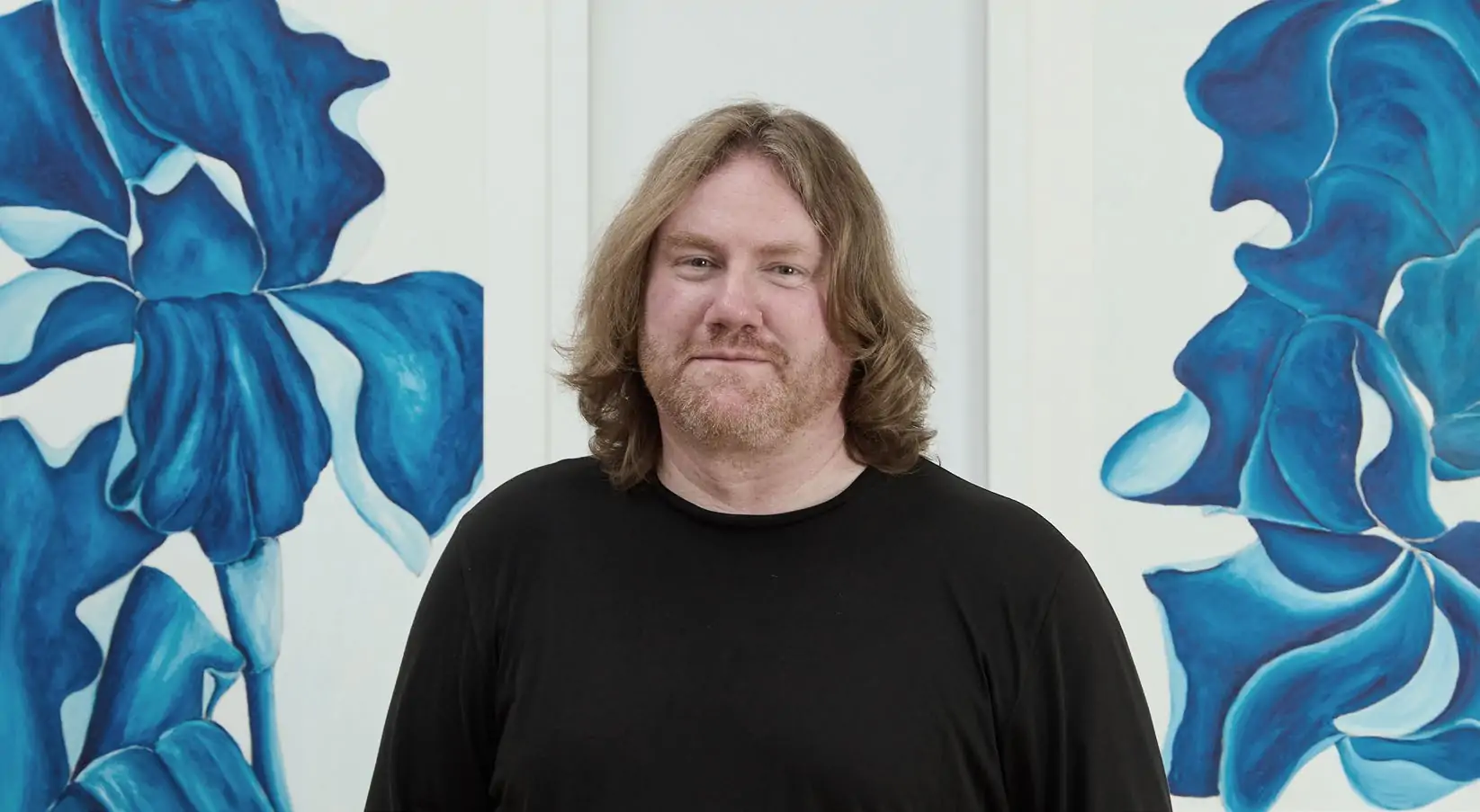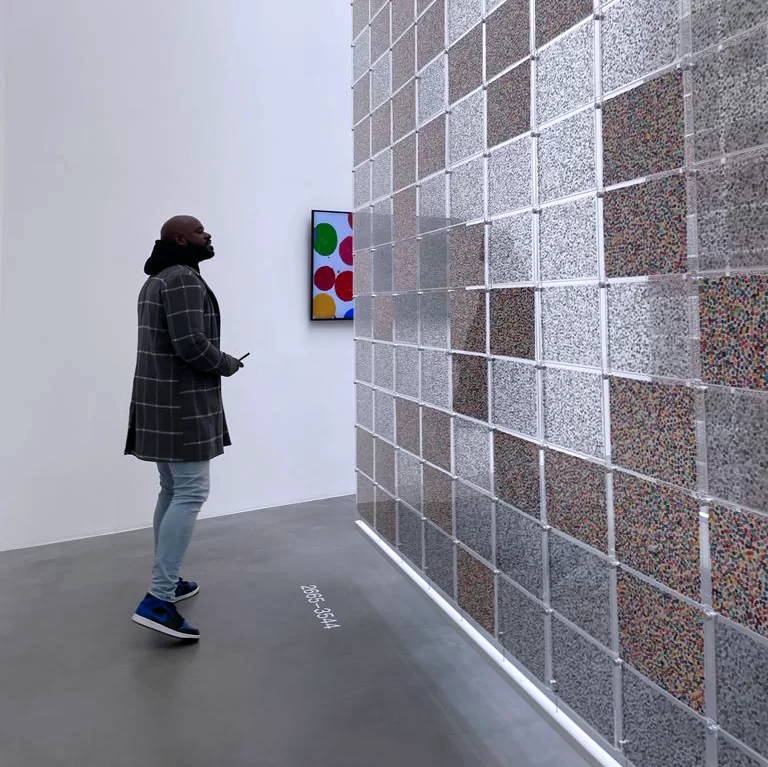In porcelain and colour, Paul Cummins renders the ephemeral visible, giving form to remembrance and the vanishing grace of beauty.
“La fleur est éphémère, mais sa beauté touche l’éternité.”
(The flower is ephemeral, but its beauty touches eternity.)
Paul Cummins MBE doesn’t speak in sweeping statements. His art, however, speaks volumes.
With a practice rooted in craft and shaped by empathy, Cummins has spent years transforming the delicate into the durable. A ceramicist by training and instinct, he creates floral sculptures that are as much about absence as they are about presence. His works don’t simply represent flowers-they become vessels for lives, silences, and shared moments of reflection.
“The flowers you see in pieces like Florian and Floralia are created by hand, each petal sculpted – with its own unique characteristics and idiosyncrasies,” he says. For Cummins, no flower is ever just a flower. Each one is a stand-in for a life-captured in clay, cast in time.
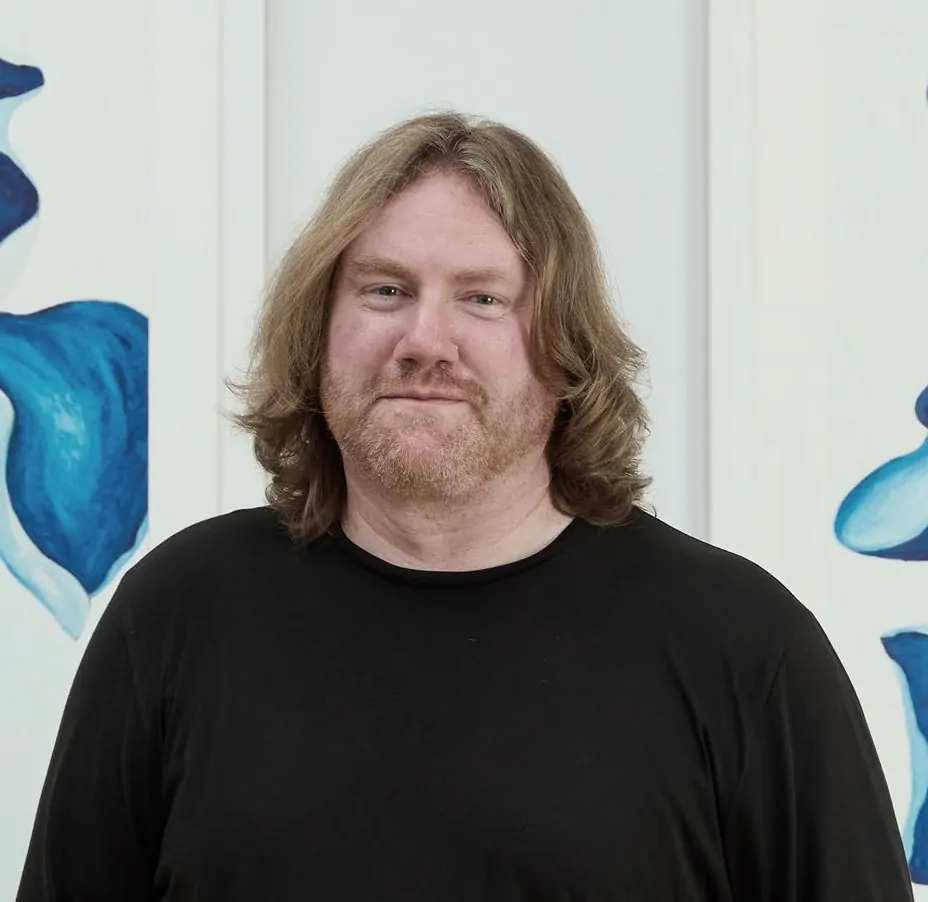
Courtesy of the artist and Halcyon
I wanted to produce a more intimate work that still represented the fragility of the flower, but also our fragility as well. We are so fragile
Paul Cummins MBE
Using a mix of metal armatures, hand-shaped clay, and richly layered glazes, his sculptures underscore both the variety of his materials and the emotional range of his subject matter. In large-scale installations, each bloom becomes part of a quiet chorus: collective yet distinct, fragile yet resolute. The paradox is deliberate: thousands of handcrafted blooms, each singular, yet united by a common form. “We are all individuals, and this is represented by the clay that is moulded… and the colour, the red, is the uniform which unites everybody into one piece.” Here, artistry meets ethics. The work is not decorative. It is commemorative.
Cummins has suffered for this vision-physically and emotionally. Midway through a major public installation, he severely injured his hand. He returned to work a week after surgery. “I haven’t really thought about it since,” he says, characteristically understated. But the toll is there-in the shift towards quieter, more restrained works like Florian, where unglazed white roses evoke the fragility not just of flowers, but of us.
What’s remarkable is how his pieces resist explanation. They don’t lecture. They linger. At Chiswick Park, at Blenheim Palace, at the Tower of London-his installations seem to grow from the land itself, shaped by topography and memory alike. And when they’re gone, the absence is palpable. “You need to feel like it has always belonged there,” he says. “Basically, it’s the reaction – what is it going to be like when it’s gone?”
Cummins has never claimed to make sense of war, grief, or illness-only to hold it in form long enough for us to feel something we otherwise might turn away from. That is his gift: not permanence, but presence. Not answers, but resonance.
His work is currently on view at Halcyon’s Summer Exhibition on New Bond Street, including Floralia, a sweeping poppy installation, alongside Florian and a series of floral paintings.
And if, as he says, people are what surprised him most in this journey-from a studio in Derbyshire to the world’s stage-then perhaps that’s all we need to understand. The work begins with him, but it ends with us.
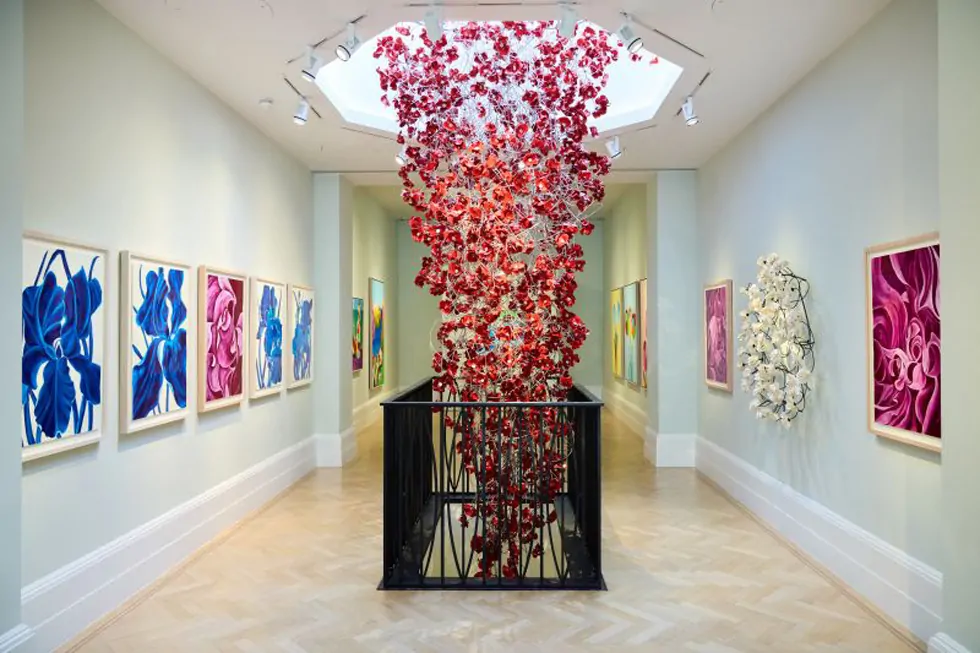
Courtesy of Halcyon
Each of your ceramic flowers is handcrafted and distinct, yet they exist within vast collectives. How do you reconcile the tension between individuality and mass scale—both philosophically and practically?
Paul Cummins MBE: The flowers you see in pieces like Florian and Floralia are created by hand, each petal sculpted – with its own unique characteristics and idiosyncrasies. For the installation at the Tower of London each poppy was handmade to represent us – the people who went to fight the first and second world war. We are all individuals, and this is represented by the clay that is moulded. Three hundred people contributed towards it, so each flower is also slightly different. And the colour, the red, is the uniform which unites everybody into one piece.
Philosophically, we’re all individuals and we all have our own stories. A lot of people thought that the war would be over in a week and when the realisation that it was going to take years hit, people died on mass…and it’s the idea of grasping this realisation. Each flower represented one life and people understand this.
“Blood Swept Lands and Seas of Red” became a national moment of reflection. At what stage did you realise the depth of its emotional and cultural impact?
Paul Cummins MBE: It was probably a little time afterwards, as I had the time to reflect. There was a moment that struck me about halfway through, when I had to let it go, else it would have sent me barmy. Because I don’t really know why it happened like it did, but the whole
exhibition became everybody’s. It became anyone who reflected, anyone who took a moment in time to think about it. It did stop London for quite a while.
Especially towards the end, when tube stations shut down and there were so many people there. But it’s that moment of reflection and in that moment, I had to realise that it was not my project anymore. I made it; I came up with it and did what I did, but it became everybody’s. The ‘Last Post’ played every night, and there was a roll call of names read by many different people from all walks of life, and it managed to stop everyone and it’s that part that I must let go of as it would be too much for me to hold. This belonged to everyone.”
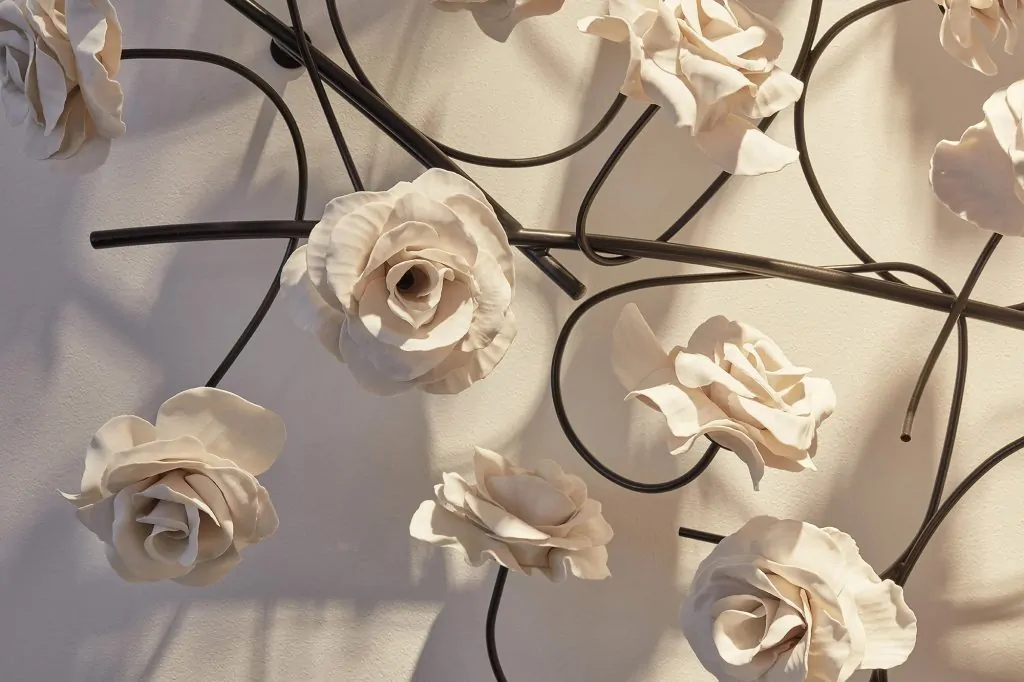
Powder coated stainless steel and unglazed porcelain
150 x 150 x 25 cm
Courtesy of Halcyon
Injuring yourself during the production of the Tower installation added an unexpected personal cost. Did that experience change the way you relate to the work or to the physical demands of creating at such scale?
Paul Cummins MBE: I didn’t really have the time to think about it. I was in hospital for a fortnight having my hand put back together and I went back to work a week afterwards. I haven’t really thought about it since! It has taken a long time for my hand to do what I want it to do. I miss being able to do a lot of agile things with it, but I am also determined for it not to affect me too much.
Your work often captures the fleeting beauty of flowers but renders them permanent in ceramic. Are you seeking to resist time—or to mark it?
Paul Cummins MBE: I relate flowers to people and we’re transient. I think I am trying to capture a moment in time…a week to a flower, could be a lifetime to us.
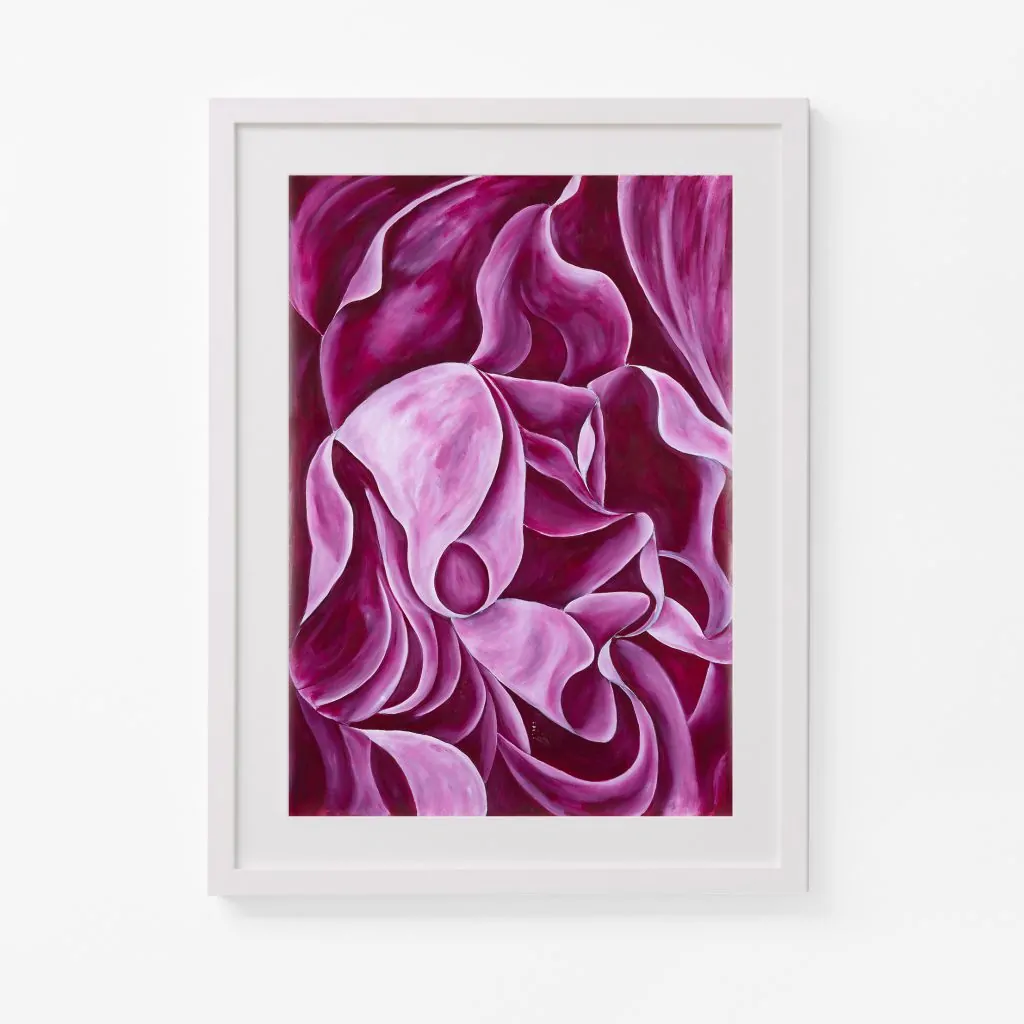
Mixed media on paper
100 x 70 cm
Courtesy of Halcyon
Having started in architectural model making, do you find echoes of that discipline in how you construct spatial compositions within your installations?
Paul Cummins MBE: Yes and no. I can look at a space and see what I can do with it. If I see say six acres of land, I can work out what I’m going to do with it quite quickly, easier than I can do with a single sculpture installation in a gallery. My work is so awkward to get into small scale.
How has your experience of colour-associated dyslexia influenced your relationship with glazes and palette choice? Has it shaped your emotional language as an artist?
Paul Cummins MBE: I don’t see words or letters at all. I see a spectrum of colour that I relate to words and letters. I always say my eyesight it slightly off to the left, which means for me that I see the whole world in slightly different colours. I can look at a blue flower and see a hundred different colours in it. I can always relate it to The Starry Night picture by Van Gogh, how all the different colours are there – that’s sometimes how I see things. The words are a picture to me, and I must decipher it in a different way. That’s the dyslexia side of things. I like intensity, over-exaggeration and vibrancy when it comes to colour. I choose a lot of blue as I can intensify this colour in the way that I want to.
To make a glaze is like a set recipe, like a cake, you must have the ingredients right, but if I can make a base glaze that is transparent that I can add colour to, I then take months and years to experiment until I can get a vibrant filler. With the Klein blue, that’s how I relate the painting that I do because each painting is made by the flower that I do. So I get an iris flower and then work out how many thousands of these do I need for a picture and distil it down until I get the perfect colour for me.
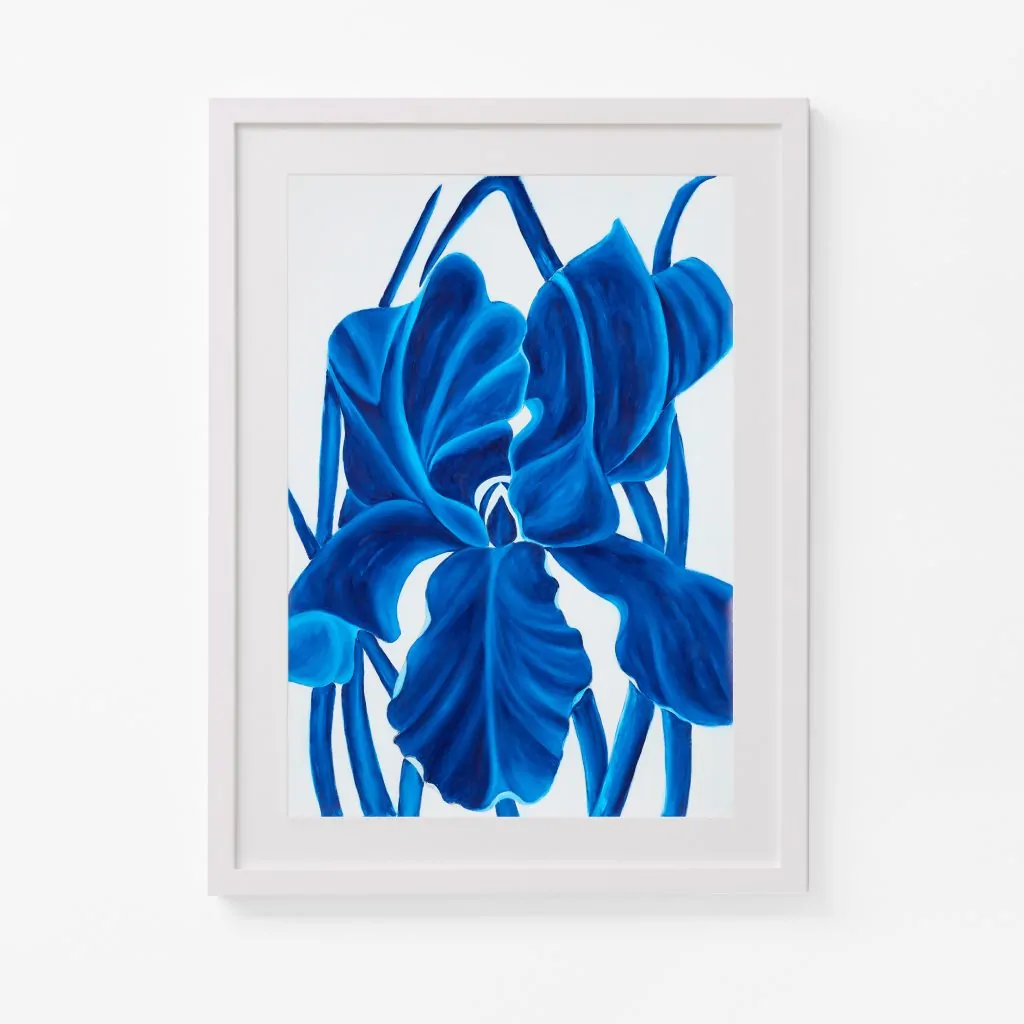
Mixed media on paper
100 x 70 cm
Courtesy of Halcyon
In “Candy”, you moved towards themes of consumption and the commodification of nature. How did that conceptual shift emerge from your earlier commemorative pieces?
Paul Cummins MBE: Candy is a strain of cancer. The piece was to highlight that something deadly could be beautiful. Because the aids virus looks like a Christmas tree under a microscope.
In my head I am trying to make things like war and cancer in a more beautiful way that we can relate to. If you see something beautiful, you want to investigate what it’s all about. And I need to make my work relatable enough to people to spark an interest, so they investigate it and have a personal relationship with it. I feel that if I have to explain what something is, I’ve failed.
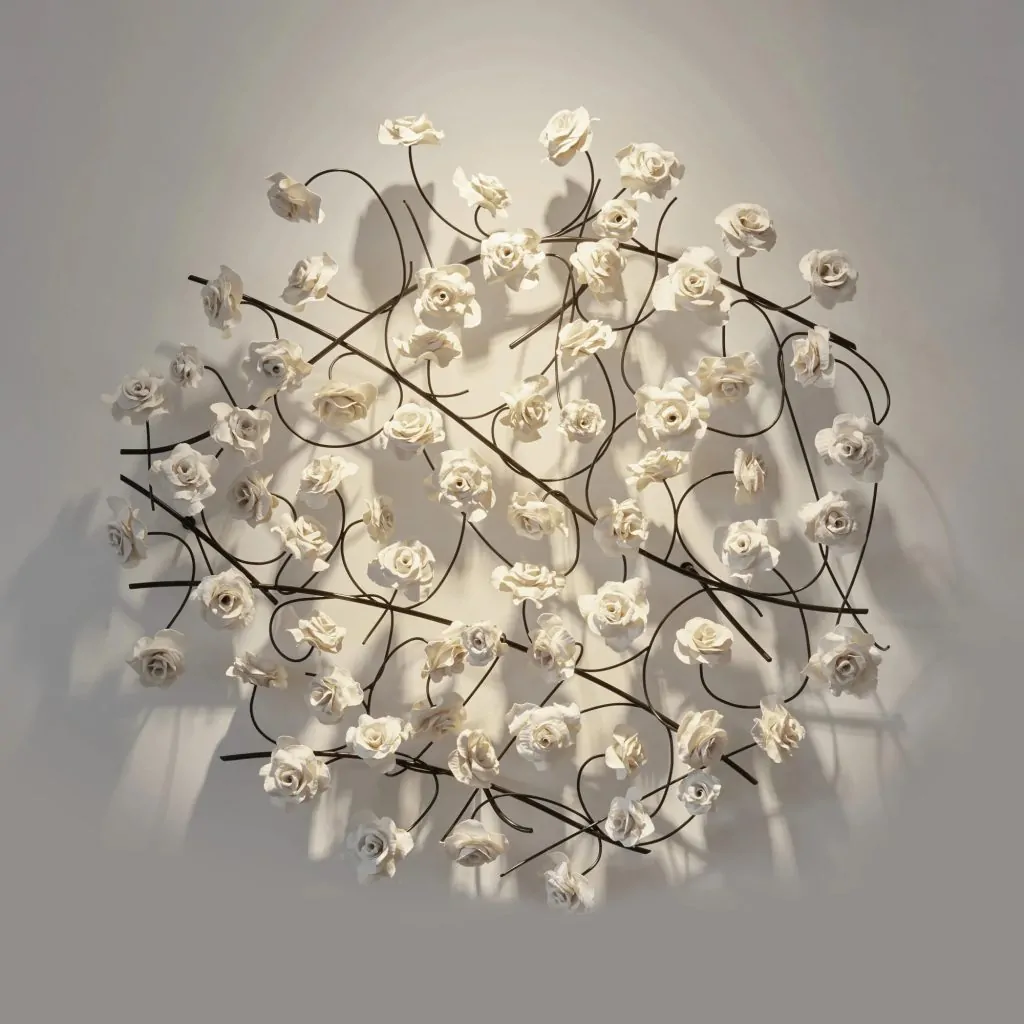
Powder coated stainless steel and unglazed porcelain
150 x 150 x 25 cm
Courtesy of Halcyon
With your more recent works, such as the unglazed white roses in “Florian”, you’ve embraced restraint and fragility. What prompted this move towards quieter, more minimalist expressions?
Paul Cummins MBE: I wanted to produce a more intimate work that still represented the fragility of the flower, but also our fragility as well. We are so fragile. I look at each flower as transient and fragile but beautiful and that’s how I see us as well in our own ways.
If I’m producing a Florian which is quite a small piece that you can have in a home, you must be able to live with it and want to look at it but also interact with it in a different way.
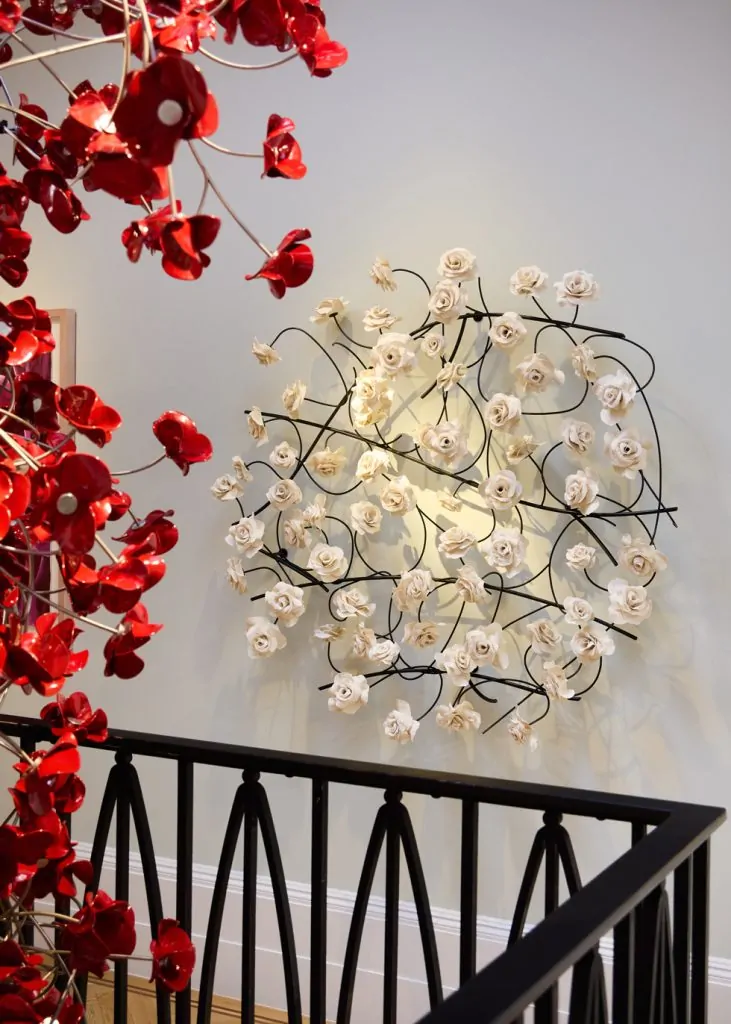
Courtesy of Halcyon
Your installations often occupy emotionally charged sites—from the Tower of London to Blenheim Palace. How much does the location influence the form and tone of the work?
Paul Cummins MBE: I pick a flower, I find a place and the whole installation is done around the landscape of that place. It has to interact with the surroundings, or it won’t work. It is an installation, but it is also ‘land art’ as you have the curvatures of the land. With The Tower, it was the building and the moat giving that natural progression.
With other places such as Blenheim and Chiswick Park, it was the actual contours of the land and the beauty around it that influenced the work. You have to let the work interact with its environment. You need to feel like it has always belonged there.
Basically, it’s the reaction – what is it going to be like when it’s gone? How will you feel about it? With The Tower, it was obvious. The moat was emptied and left as a muddy field until it was repaired so it is the aftermath of something being removed as well that you have to think about. Because it is a massive change for the environment putting it in, but it is also a huge change to remove it afterwards.
Looking back, what has most surprised you about the journey—from a ceramicist working in Derbyshire to the creator of one of the most recognisable public memorials of recent times?
Paul Cummins MBE: People.
©2025 Paul Cummins MBE


